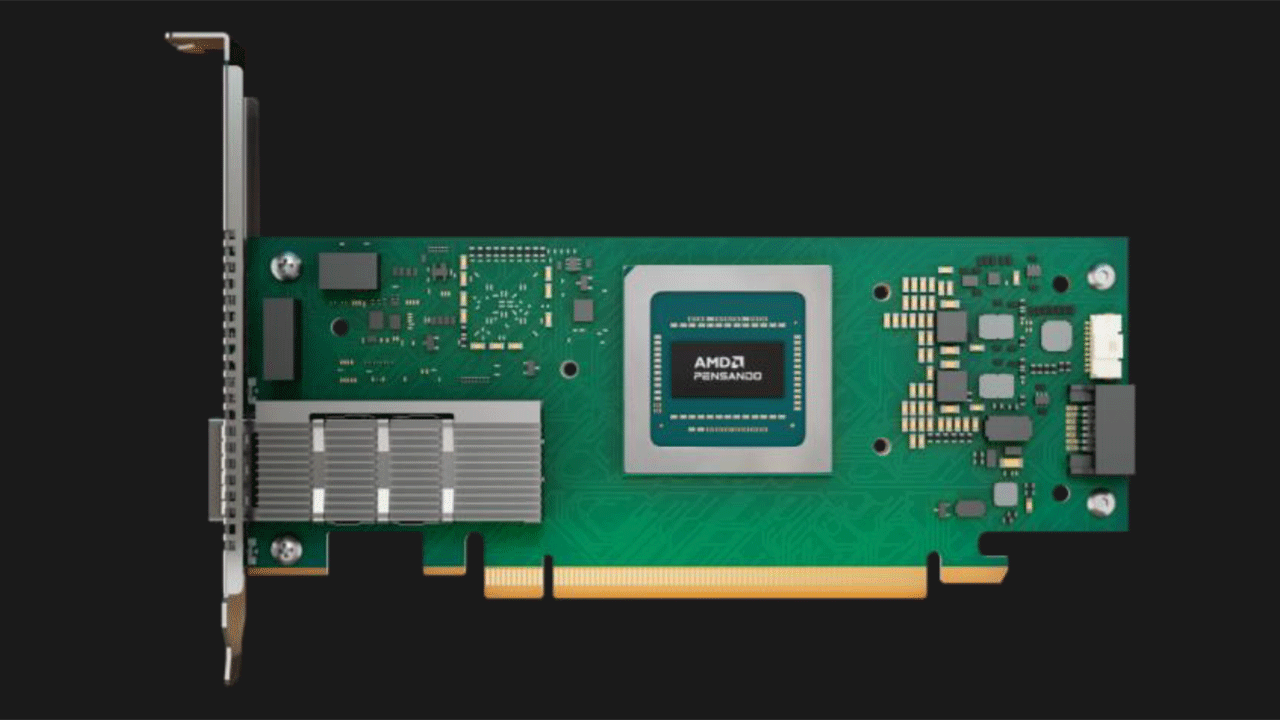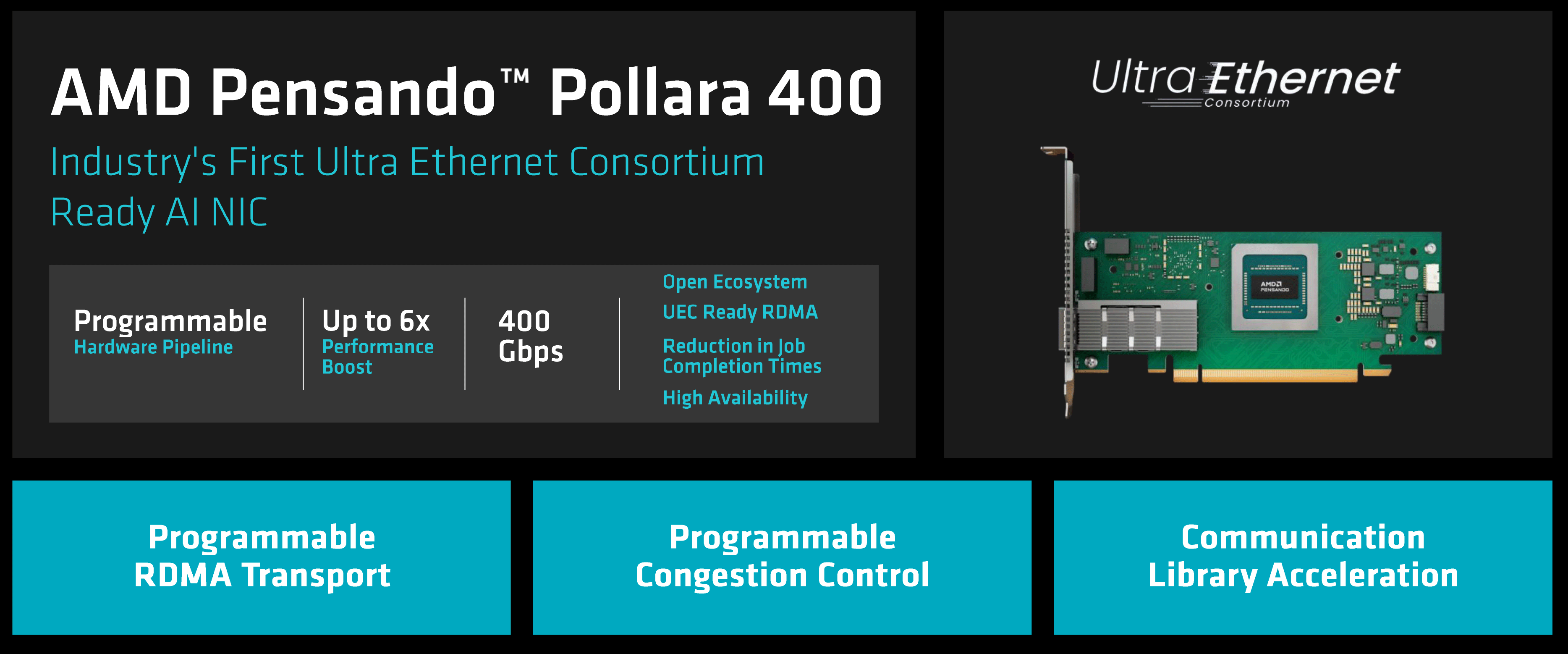AMD unveils industry's first Ultra Ethernet ready network card for AI and HPC
Even though the final UEC 1.0 specification is due in Q1 2025.

The Ultra Ethernet Consortium (UEC) has delayed release of the version 1.0 of specification from Q3 2024 to Q1 2025, but it looks like AMD is ready to announce an actual network interface card for AI datacenters that is ready to be deployed into Ultra Ethernet datacenters. The new unit is the AMD Pensando Pollara 400, which promises an up to six times performance boost for AI workloads.
The AMD Pensando Pollara 400 is a 400 GbE Ultra Ethernet card based on a processor designed by the company's Pensando unit. The network processor features a processor with a programmable hardware pipeline, programmable RDMA transport, programmable congestion control, and communication library acceleration. The NIC will sample in the fourth quarter and will be commercially available in the first half of 2025, just after the Ultra Ethernet Consortium formally publishes the UEC 1.0 specification.
The AMD Pensando Pollara 400 AI NIC is designed to optimize AI and HPC networking through several advanced capabilities. One of its key features is intelligent multipathing, which dynamically distributes data packets across optimal routes, preventing network congestion and improving overall efficiency. The NIC also includes path-aware congestion control, which reroutes data away from temporarily congested paths to ensure continuous high-speed data flow.
Additionally, the Pollara 400 offers fast failover, quickly detecting and bypassing network failures to maintain uninterrupted GPU-to-GPU communication delivering robust performance while maximizing utilization of AI clusters and minimizing latency. These features promise to enhance the scalability and reliability of AI infrastructure, making it suitable for large-scale deployments.
The Ultra Ethernet Consortium now includes 97 members, up from 55 in March, 2024. The UEC 1.0 specification is designed to scale the ubiquitous Ethernet technology in terms of performance and features for AI and HPC workloads. The new spec will reuse as much as possible from the original technology to maintain cost efficiency and interoperability. The specification will feature different profiles for AI and HPC; while these workloads have much in common, they are considerably different, so to maximize efficiency there will be separate protocols.
Get Tom's Hardware's best news and in-depth reviews, straight to your inbox.

Anton Shilov is a contributing writer at Tom’s Hardware. Over the past couple of decades, he has covered everything from CPUs and GPUs to supercomputers and from modern process technologies and latest fab tools to high-tech industry trends.
-
Jame5 So we are just going the route of consumer wifi routers? Releasing products before the spec is finalized?Reply -
CaptRiker 400 Gbit? ouch.. is that over fibre? seems rj 45 cables would ne to be really really short lolReply -
coolestcarl Reply
Yes, beautiful, beautiful, high-speed backups and media transfer for NAS.dimar said:Any advantages for using Ultra Ethernet in consumer PCs? -
Nikolay Mihaylov Reply
Of course it is over fibre. RJ45 only goes up to 10Gbps. I think there are specs for 25 and 40 Gbps over TP cable (cat 7 and 8?) but I am not aware of any implementation. There are high speed copper cables, at least up to 100Gbps of the QSFP28 DAC variety but these are a different beast and have always been pretty short to begin with.CaptRiker said:400 Gbit? ouch.. is that over fibre? seems rj 45 cables would ne to be really really short lol
BTW, fibre is relatively cheap. It's the transceivers that are expensive. -
AkroZ Reply
For that you need a NAS able to write/read data at 400Gbps. As best NVME disks are around 120Gbps, with 4 disks in raid it's doable. But a motherboard with 4 disks with PCIe Gen 5 and the network card is costly.coolestcarl said:Yes, beautiful, beautiful, high-speed backups and media transfer for NAS. -
das_stig Reply
Windows and all your home appliance's can finally have all the bandwidth they need to report home and ensure your tracked, categorised and targeted efficiently.coolestcarl said:Yes, beautiful, beautiful, high-speed backups and media transfer for NAS. -
JAMESDWI Reply
This just leaves me with a couple questions, with 4x 60TB SSD's that can handle enough data from such a network, it sounds cool, but what do you do after the first 5 minutes, when your 4 SSD drives are now full? Where does the data go? Where are you going to get your next 240TB of data to process. Not like you are going to get a 400 gigabit link to the internet that won't cost more than your house is worth, each month.AkroZ said:For that you need a NAS able to write/read data at 400Gbps. As best NVME disks are around 120Gbps, with 4 disks in raid it's doable. But a motherboard with 4 disks with PCIe Gen 5 and the network card is costly.
Next question is. given that a 60TB SSD drive is around $16,000 I know they exist but no one is providing a quote, so estimating based on the price of 15TB SSD drives. Where do you find your next $64,000 to double the size of your NAS/SAN system, now this doesn't account for the cost of expanding the size of the current NAS just drives to do it. -
Samlebon2306 Replydimar said:Any advantages for using Ultra Ethernet in consumer PCs?
You absolutely need it to watch 128K movies at 500 fps. -
hotaru251 Pensando Pollara....Reply
please tech industry start using short simple names for your stuff... "Pensando Pollara" is just long and wtf for no reason.
Just call it the AMD UE (Ultra Ethernet) 1G400 (1st gen 400Gb speed).
